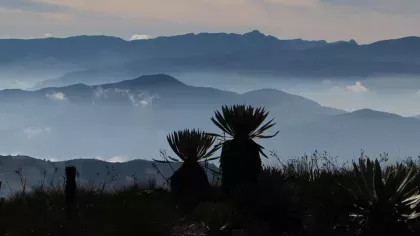24 August 2022
An artist's take on the ‘Andean sponge’ plants providing clean water to Colombia
Find out why we’ve suspended a 24ft moving sculpture over our steepest ravine

As part of our summer of art at Wakehurst, Nourish, we’ve commissioned five artists to create works that respond to the work of our scientists here at Kew.
A 24ft sculpture you say?
Yes, this 24-foot epic, Isla, was created by American artist, John Grade. The towering artwork now hangs suspended over the steep ravine of Wakehurst’s Westwood Valley.
The installation is made from 4,000 individual resin pieces, and spans 100 feet between the trees that support it on either side of the valley.
Did you know?
What’s it all about?
In a stunning display inspired by the frailejón plant, the installation collects and releases rainwater, moving in tune with the elements.
“The sculpture collects water by channeling rain through its leaves into its lower base. The sculpture then divides in half, and the lower half drops vertically towards the ground, very slowly," explains the artist, John Grade.
“As the water gradually evaporates, the bottom of the sculpture slowly rises back into unison with the upper half.”
"This process mimics the capacity of the frailejón to collect and store water during the dry seasons in the Páramo,” he said.









And it’s inspired by Kew science?
Yes, Isla takes inspiration from the work of Kew Scientist Dr Mauricio Diazgranados Cadelo. He and his team are researching a very special ecosystem called the Páramo.
Páramos exist along the misty Andean mountain range in Venezuela, Colombia, Ecuador and Northern Peru.
Páramos are incredible. They are critical for the survival of millions of people, as they provide the main source of clean water for people living in cities including Bogotá, Colombia’s capital.
But how?
Well, plants like the frailejón, part of the sunflower family, (translated from Spanish as 'big monk' - you can see why from the photos above!) are said to function almost like a giant sponge. They capture water vapor from passing clouds and rainfall in their spongy trunks, store it, and then release it through their roots into the soil, helping to create vast water deposits and lakes.
Páramos release water slowly and steadily, which is particularly important in dry seasons.
So, what are Kew doing in Colombia?
Unfortunately, the area covered by Páramos is shrinking at an alarming pace, due to increased temperatures and changes in rainfall patterns.
At Kew, we are working with local partners in Colombia to analyse how the Páramo functions, both above and below ground, and how we can protect it.
The Páramos have been used for centuries as a source of medicinal plants, grazing and agricultural land for indigenous peoples, and an important source of water.
Our work will establish how plant and habitat diversity contributes to water regulation; identify and quantify how crop and livestock farmers engage with and affect the Páramo; and provide a better understanding of Páramo functioning, enabling sustainable and conflict-free solutions.
How can I see the installation?
Come and join us at Wakehurst for Nourish, a summer of art inspired by Kew science!
Discover the future of plants and food, and nourish your mind and body as you encounter five striking new installations in our wild landscape.
Families can enjoy the Nourish children’s trail – perfect for little explorers.


